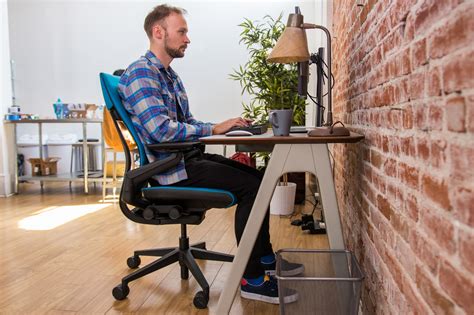Working from home has become a common practice for many people, and with that comes the need to create a comfortable and productive home office setup. One key aspect to consider when setting up your home office is ergonomics. Understanding and incorporating ergonomics in your home office setup can help prevent injuries, improve productivity, and enhance overall well-being. In this blog post, we will explore the basics of ergonomics and provide tips on how to choose the right furniture, optimize your workstation layout, and set up ergonomic keyboards and mice. We will also discuss the importance of proper lighting, share tips for improving posture and avoiding strain, and emphasize the importance of implementing regular breaks and stretching exercises. By implementing the principles of ergonomics in your home office, you can create a workspace that promotes comfort, productivity, and overall health.
Understanding the Basics of Ergonomics
When it comes to creating a comfortable and efficient workspace, understanding the basics of ergonomics is essential. Ergonomics is the study of people’s efficiency in their working environment and focuses on designing equipment and furniture that fits the human body’s natural movements and capabilities. This not only helps prevent discomfort and injury, but it also enhances productivity and overall well-being.
One of the primary principles of ergonomics is ensuring that the workstation is set up in a way that minimizes strain and fatigue. This involves proper positioning of the computer monitor, keyboard, and mouse to promote a neutral posture and reduce the risk of musculoskeletal disorders. Additionally, using adjustable furniture and accessories allows for customization based on individual needs and preferences, further promoting comfort and productivity.
Another fundamental aspect of ergonomics is the importance of movement and variation throughout the workday. Encouraging regular breaks, stretching exercises, and changes in posture can help prevent stiffness, promote circulation, and reduce the negative effects of prolonged sitting. Implementing these strategies not only benefits physical health but also contributes to mental alertness and overall job satisfaction.
In conclusion, understanding the basics of ergonomics is vital for creating a workspace that supports optimal health, comfort, and productivity. By incorporating ergonomic principles into the design and layout of your home office, you can minimize the risk of discomfort and injury while maximizing your overall well-being and efficiency.
Choosing the Right Furniture for Your Home Office
When setting up a home office, one of the most important considerations is choosing the right furniture. Your office furniture plays a significant role in your productivity, comfort, and overall well-being. It is important to select ergonomic furniture that supports your body and promotes good posture.
Start by investing in a comfortable and supportive office chair that is adjustable and provides proper lumbar support. Look for a chair with adjustable armrests and seat height to ensure that it can be customized to fit your body and sitting preferences.
Additionally, choose a desk that is spacious enough to accommodate your work essentials, such as a computer, keyboard, mouse, and other accessories. A desk with adjustable height options can allow you to alternate between sitting and standing, promoting movement throughout the day.
Lastly, don’t forget to consider storage when selecting furniture for your home office. Shelves, cabinets, and drawers can help you keep your workspace organized and clutter-free, contributing to a more efficient and pleasant working environment.
Optimizing Your Workstation Layout for Ergonomics
When it comes to creating an ergonomic workspace, the layout of your workstation plays a crucial role in promoting comfort and preventing strain. An optimized workstation layout can help improve your posture and overall productivity.
One of the key considerations for optimizing your workstation layout is to ensure that your computer monitor is positioned at eye level. This helps reduce neck strain and prevents you from constantly looking down or craning your neck to see the screen.
Adjustable furniture is also essential for creating an ergonomic workstation layout. Investing in an adjustable desk and chair can provide you with the flexibility to customize your workspace to best suit your individual needs and preferences.
Another important aspect to consider is the placement of frequently used items within arm’s reach. This can minimize repetitive reaching and twisting, which can lead to muscle strain and discomfort over time. Organizing your desk to keep essential items within easy reach can help improve efficiency and reduce the risk of injury.
Importance of Proper Lighting in Your Home Office
Proper lighting in your home office is crucial for creating a comfortable and productive work environment. Good lighting can reduce eye strain and headaches, ultimately enhancing your overall well-being. When setting up your home office, it’s important to consider the placement of lights and the type of light fixtures you choose.
One of the key factors to consider when it comes to proper lighting is natural light. Natural light not only brightens up your space, but it also has a positive impact on your mood and energy levels. Try to position your desk near a window to maximize the benefits of natural light in your home office.
In addition to natural light, it’s important to have adequate artificial lighting in your home office. Desk lamps and overhead lights can help create a well-lit workspace, reducing the strain on your eyes. Consider using LED bulbs which are known for their energy efficiency and ability to mimic natural light.
Overall, proper lighting in your home office plays a significant role in your productivity and well-being. By optimizing the lighting environment, you can create a more comfortable and visually appealing workspace, ultimately improving your work experience.
Ergonomic Keyboard and Mouse Setup
When setting up your home office, it’s important to consider the ergonomics of your keyboard and mouse setup. The right equipment can make a significant difference in your comfort and productivity throughout the workday.
First and foremost, it’s crucial to select a keyboard and mouse that are designed with ergonomic principles in mind. Look for options that provide adequate support for your wrists and promote a natural hand position. This can help prevent strain and discomfort during long periods of use.
Additionally, consider the placement of your keyboard and mouse on your desk. Position them in a way that allows your arms to rest comfortably at your sides, with your elbows bent at a 90-degree angle. This can help minimize stress on your shoulders and upper back, promoting a more ergonomic posture.
Finally, don’t forget to take advantage of any customization features that your keyboard and mouse may offer. Adjust the sensitivity of your mouse and the key response of your keyboard to suit your individual preferences. This can further enhance your ergonomic experience and help reduce the risk of repetitive strain injuries.
Tips for Improving Posture and Avoiding Strain
Improving posture and avoiding strain are essential for maintaining good health, especially for those who spend long hours working at a desk. One important tip for improving posture is to ensure that your computer monitor is at eye level to prevent straining your neck and shoulders. Additionally, it is crucial to sit with your back straight and shoulders relaxed to avoid slouching, which can lead to back pain.
Another important tip is to have an ergonomic chair that provides proper support to your lower back. A chair with adjustable armrests can also help in maintaining a good posture by allowing you to keep your arms at a comfortable position while typing or using the mouse. Moreover, taking short breaks to stand up and stretch every hour can help alleviate tension and prevent muscle strain.
Furthermore, it is important to be mindful of your keyboard and mouse placement. Your keyboard should be positioned at elbow height to ensure that your arms are at a comfortable angle while typing. Using an ergonomic keyboard and mouse can also help in reducing strain on the wrists and fingers. Additionally, incorporating stretching exercises into your daily routine can improve flexibility and prevent stiffness.
Lastly, implementing proper lighting in your workspace is crucial for reducing eye strain and maintaining good posture. Natural light is the best option, but if that is not available, using adjustable lighting with adequate brightness can help in reducing eye fatigue. By following these tips, you can significantly improve your posture and reduce the risk of strain and discomfort while working.
Implementing Regular Breaks and Stretching Exercises
Many people spend long hours sitting at their desks, hunched over their computers, which can lead to stiffness and discomfort. It’s important to make time for regular breaks and stretching exercises throughout the day to relieve tension and prevent strain. Taking short breaks every hour to stretch and move around can help improve circulation and reduce the risk of developing musculoskeletal issues.
One effective stretching exercise is the shoulder roll, which involves rolling your shoulders in a circular motion to release tension in the upper back and shoulders. Another beneficial exercise is the neck stretch, which involves tilting your head to one side and holding for a few seconds before repeating on the other side. These simple exercises can be done at your desk and can help to improve flexibility and reduce discomfort.
In addition to incorporating stretching exercises into your daily routine, it’s also important to take regular breaks to stand up, stretch, and move around. Setting a timer to remind yourself to take a break every hour can help you stay on track and prevent yourself from getting too caught up in your work. Use this time to walk around, do some light stretching, or even just take a few moments to relax and clear your mind. Regular breaks are essential for maintaining good physical and mental health.
By implementing regular breaks and stretching exercises into your daily work routine, you can reduce the risk of developing musculoskeletal issues, improve your overall health and well-being, and increase your productivity. Don’t underestimate the power of taking a few minutes throughout the day to focus on your physical and mental well-being. Your body will thank you for it!





